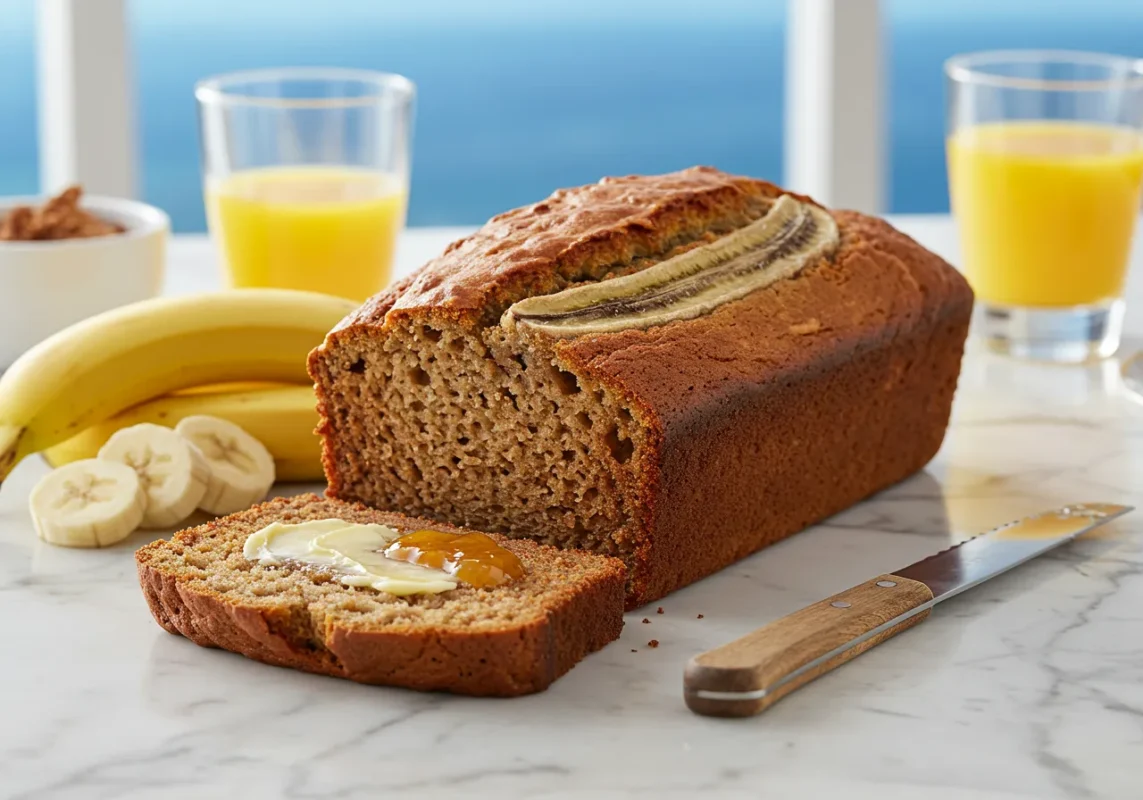Banana bread is much more than just a quick bake; it evokes warmth and comfort while promising deliciousness with every slice. Our moist banana bread recipe with sour cream takes this classic favorite to new heights. Its moist, fluffy texture combined with the subtle tang from the sour cream creates a loaf that is bound to become a staple in your baking repertoire.
This article will not only provide you with this exceptional recipe but will also address some common queries surrounding banana bread baking. Whether you’re a seasoned baker or attempting it for the first time, we’ll make sure you find all the encouragement and guidance you need.
Recipe
Moist Banana Bread Recipe with Sour Cream
Step 1: Ingredients You’ll Need
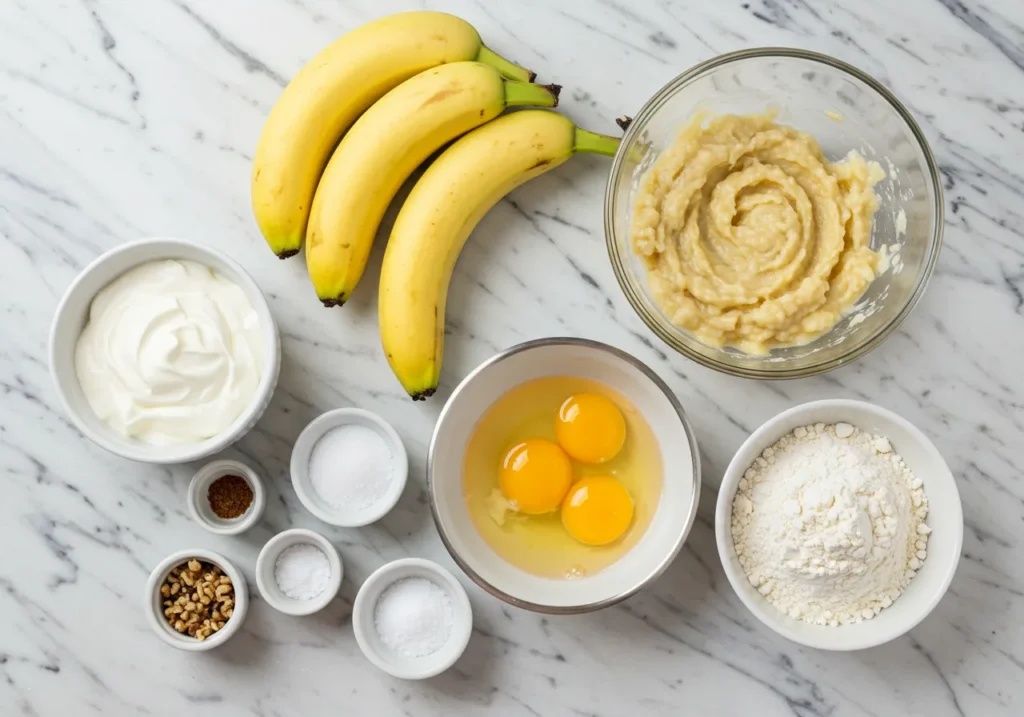
Step 2: Preheat Your Oven + Prepare Your Loaf Pan
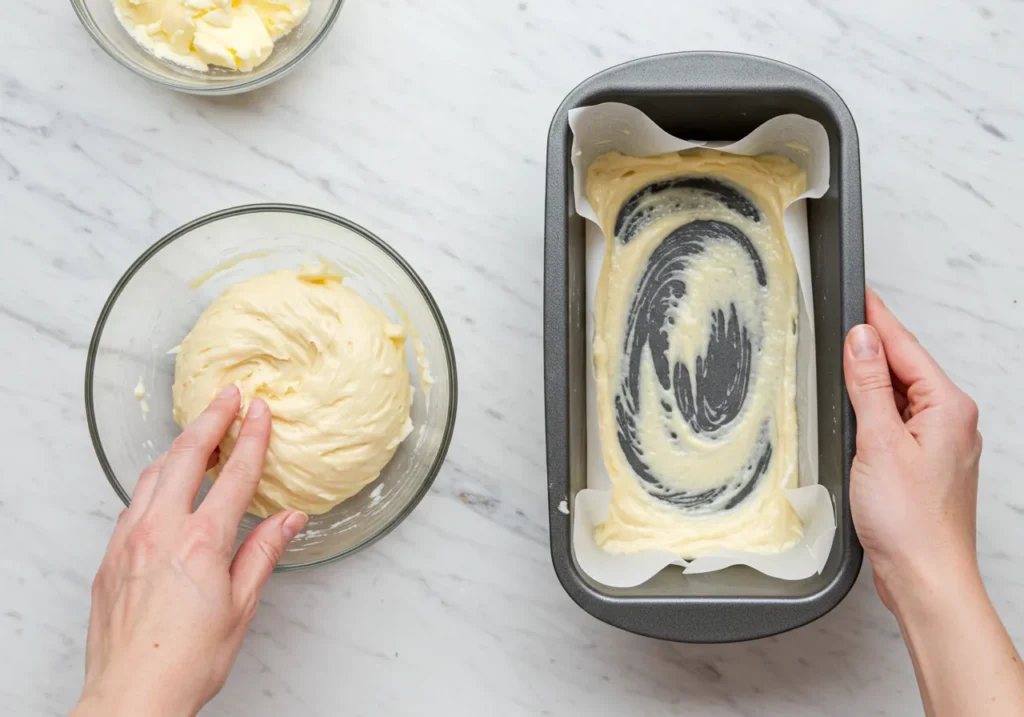
Step 3: Mix the Wet Ingredients + Combine Dry Ingredients
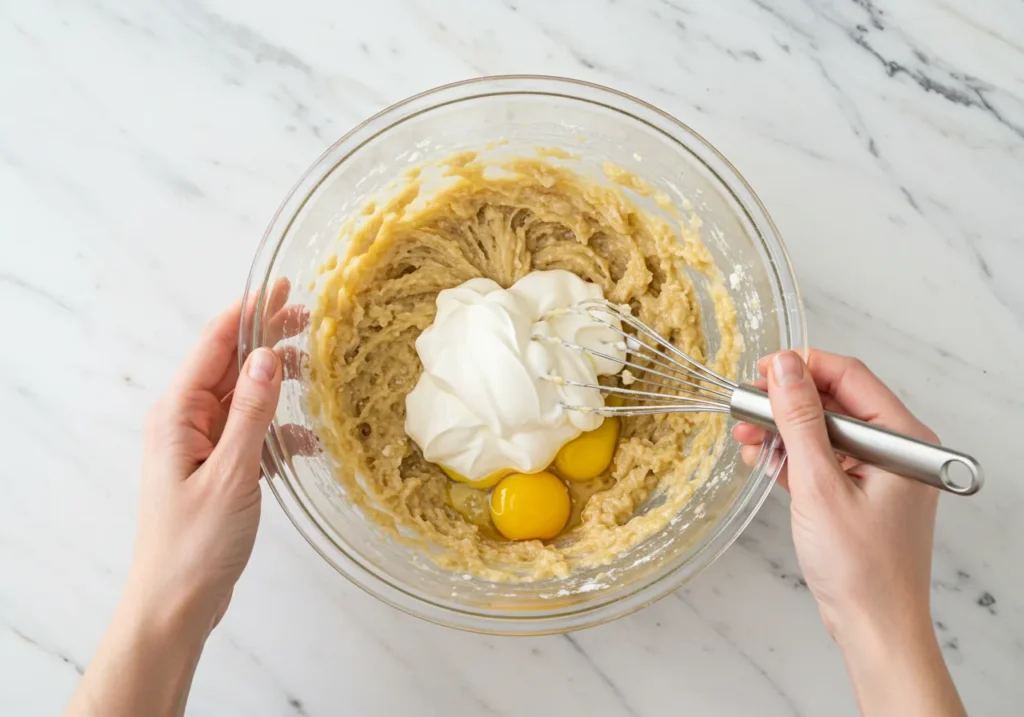
Step 4: Pour the batter + Bake to Perfection
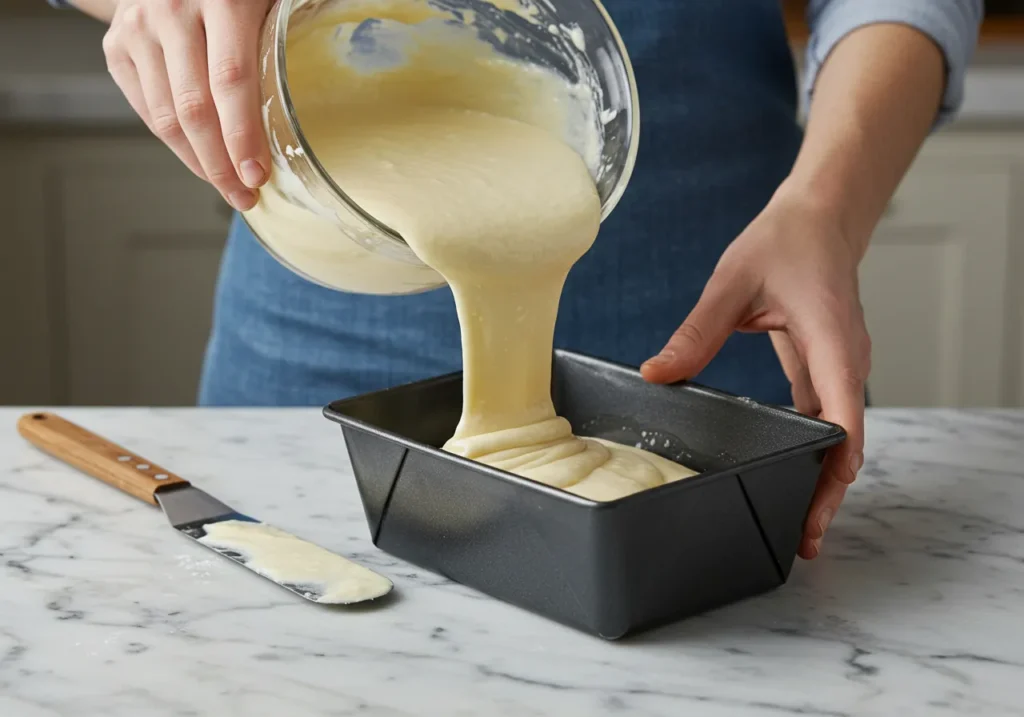
Step 5: Voila
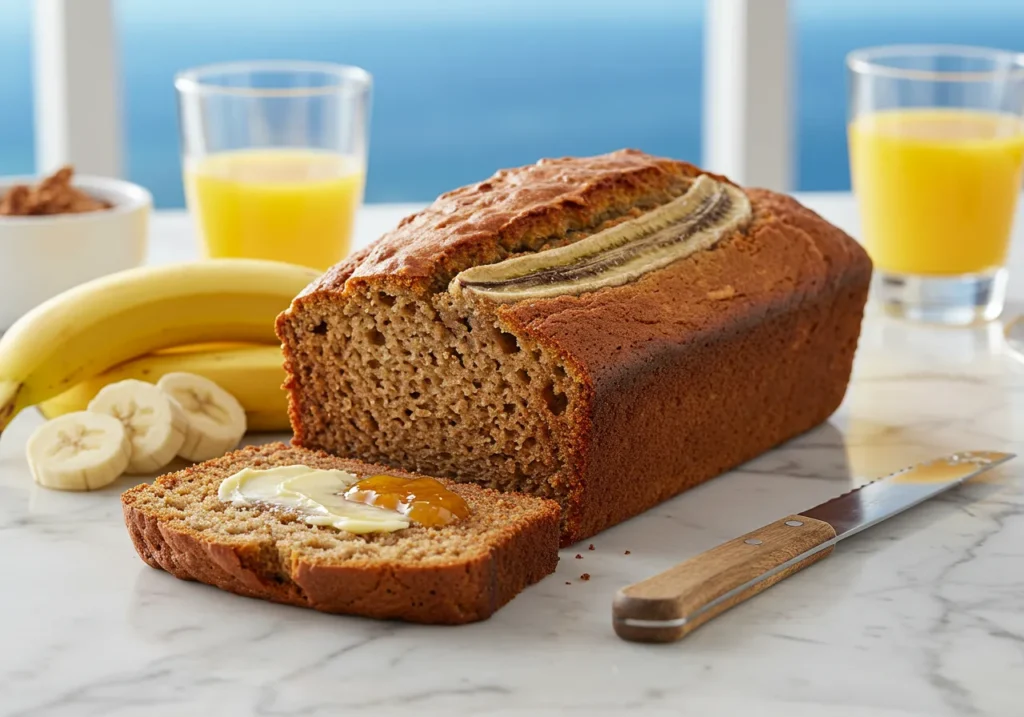
What is the number one mistake made when making banana bread?
The most common mistake in making banana bread is overmixing the batter. This can activate gluten in the flour, resulting in a dense, gummy texture instead of the desired light and fluffy crumb. Another frequent error is improper measuring; scooping flour directly from the container can pack it down, leading to too much flour in the recipe. To avoid these issues, stir just until the dry ingredients are incorporated and use the spoon-and-level method for accurate measurements.
What is the best oil to use when making banana bread?
Vegetable oil and canola oil are typically the best choices for banana bread due to their neutral flavors, which allow the banana taste to shine while keeping the loaf moist. While melted butter adds a rich flavor, it can sometimes lead to a denser texture. Avocado oil is another option that provides similar moisture benefits and healthy fats without altering the taste significantly. Experimenting with oils or using a combination of oil and butter can help achieve desired moisture and flavor.
Tasty
Print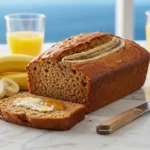
Moist Banana Bread Recipe with Sour Cream
- Total Time: 1 hour 15 minutes
Description
This inviting loaf of banana bread, enhanced with sour cream, showcases its perfectly baked exterior and tempting crumb, making it a must-try recipe for all banana bread enthusiasts.
Ingredients
-
- 3 ripe bananas (medium size, mashed)
-
- 1 cup granulated sugar
-
- 1/2 cup sour cream
-
- 1/4 cup vegetable oil or melted butter
-
- 2 large eggs
-
- 1 teaspoon vanilla extract
-
- 1 teaspoon baking soda
-
- 1 1/2 cups all-purpose flour
-
- 1/4 teaspoon salt
-
- Optional: 1/2 cup chopped walnuts or chocolate chips for added flavor
Instructions
Step 1: Preheat Your Oven
Begin your journey to creating amazing banana bread by preheating your oven to 350°F (175°C). This ensures that your loaf bakes evenly, resulting in a beautifully golden-brown crust that will tempt both your taste buds and those of your family members or guests.
Step 2: Prepare Your Loaf Pan
To avoid any sticky situations, grease a 9×5 inch loaf pan with butter or non-stick spray. For additional ease, you can also line the pan with parchment paper. This way, once the banana bread has cooled, you can effortlessly lift it out of the pan.
Step 3: Mix the Wet Ingredients
In a large mixing bowl, take the ripe bananas and mash them with a fork until they are mostly smooth. The sweetness and flavor from ripe bananas are essential in this recipe. Next, add in the granulated sugar, sour cream, vegetable oil or melted butter, eggs, and vanilla extract. Whisk the ingredients together until everything is well combined. The addition of sour cream offers a richness that guarantees your banana bread will be delightfully moist.
Step 4: Combine Dry Ingredients
In another bowl, sift together the flour, baking soda, and salt. Gradually add the dry mixture into the wet ingredients while stirring gently. Mix until just combined; this is important to avoid overmixing, which can lead to dense bread. If you’re feeling adventurous, this is the time to fold in chopped walnuts or chocolate chips!
Step 5: Bake to Perfection
Pour the batter carefully into your prepared loaf pan, smoothing out the top with a spatula if needed. Place the pan in the preheated oven and bake for 50 to 60 minutes. Keep an eye on it! You can check for doneness by inserting a toothpick in the center of the loaf; it should come out clean. Once baked to perfection, let it cool in the pan for about 10 minutes before transferring it to a wire rack to cool completely.
Notes
Choose the Right Bananas: Opt for bananas that are very ripe, speckled, or even brown. The riper the bananas, the sweeter and more flavorful your banana bread will be.
The Best Oil for Baking: When making banana bread, using a neutral oil, such as vegetable or canola oil, is ideal. Unlike butter, oil keeps the bread moist without imparting a strong flavor.
Monitor Baking Time Closely: Overbaking your banana bread is a common mistake. Check it for doneness a few minutes before the timer goes off to prevent dry bread.
Incorporate Sour Cream Wisely: Sour cream is a game-changer for moisture. If you prefer an alternative, Greek yogurt works just as well, adding moisture and a hint of tanginess.
Proper Storage Techniques: To retain moisture, wrap your banana bread tightly in plastic wrap or aluminum foil once it has completely cooled. This helps it stay fresh and moist for several days at room temperature or up to a week in the refrigerator.
- Prep Time: 15 minutes
- Cook Time: 60 minutes
- Category: Baking, Desserts
- Cuisine: American or Fusion
Nutrition
- Serving Size: 10 slices
- Calories: 205
- Sugar: 12g
- Sodium: 150mg
- Fat: 8g
- Saturated Fat: 1g
- Carbohydrates: 31g
- Fiber: 1g
- Protein: 3g
- Cholesterol: 32mg
Can bananas be too ripe for banana bread?
Overripe bananas are great for banana bread due to their sweetness and soft texture, but they can reach a point where they become too mushy or dark brown, leading to off-flavors from fermentation. At this stage, they may impart a sour or rancid taste to the loaf. Ideally, use bananas that are spotted or nearly black but still firm enough to mash easily. Always check for mold or unusual odors, as these indicate spoilage and the need to choose fresher fruit instead.
Why is my banana bread moist on top?
A moist top on banana bread may indicate that it was underbaked, as the batter may not have fully cooked through, leading to wetness. To avoid this, use the toothpick test to check for doneness; if it comes out wet, extra baking time is needed. Alternatively, high humidity or excess liquid in the batter can contribute to the moistness. Adjusting liquid ingredient amounts or using foil to cover the bread can trap steam, so achieving the right balance for optimal texture is essential.
What is unhealthy about banana bread?
Banana bread often has a reputation for being unhealthy due to high sugar and calorie counts, as many recipes include refined sugars and butter, which can lead to weight gain and metabolic issues when consumed excessively. Additionally, using white flour lacks the nutrients found in whole grains, making it less nutritious. Sugary mix-ins like chocolate chips can further increase calorie counts. However, modifications such as reducing sugar or using whole wheat flour can enhance its nutritional value while maintaining deliciousness.
Is baking soda or baking powder better for banana bread?
Baking soda is generally the preferred leavening agent in banana bread because it reacts with the natural acidity in ripe bananas, creating carbon dioxide that helps the bread rise and results in a light, fluffy texture. While baking powder can also be used, it is typically reserved for recipes without acidic ingredients. Therefore, when baking banana bread, using baking soda is ideal for harnessing the banana’s natural sugars and acidity for the best results.
How do you keep banana bread moist?
To keep banana bread moist, incorporate moisture-rich ingredients like ripe bananas, sour cream, yogurt, or applesauce into the batter. After baking, allow the bread to cool on a wire rack and then wrap it tightly with plastic wrap or aluminum foil to prevent drying. Proper storage is key; keeping it in an airtight container or freezing leftovers will help maintain freshness. Additionally, monitor baking time to prevent overbaking, which can dry out the loaf.
Proper storage is equally important in maintaining moisture after baking. Allow your freshly baked banana bread to cool completely on a wire rack, as this helps prevent excess steam from becoming trapped in the pan and causing sogginess. Once cool, wrap the bread tightly in plastic wrap or aluminum foil, or store it in an airtight container. This keeps out air and prevents the bread from drying out. Additionally, you can refrigerate or freeze leftovers to preserve freshness—just remember to wrap the loaf well before freezing to prevent freezer burn.
How many bananas are in 2 cups?
For banana bread, two cups of mashed bananas typically equal about four to five medium-sized bananas, although this can vary based on banana size. Always aim for overripe bananas, which are sweeter and easier to mash smoothly into the batter. When measuring, it’s helpful to mash the bananas thoroughly and use a measuring cup for accuracy. Well-ripened bananas not only enhance sweetness but also positively influence the bread’s overall texture and flavor.
Is butter or oil better for banana bread?
The choice between butter and oil for banana bread impacts flavor and texture. While butter adds a rich taste, it can lead to a denser loaf, whereas vegetable or canola oil tends to produce lighter, moister bread due to its ability to keep the crumb tender. A combination of both can also be beneficial, providing moisture from oil and flavor from butter. Ultimately, personal preference plays a significant role in determining which fat to use for the best results.
Ultimately, the choice comes down to personal preference. If you enjoy a richer taste and don’t mind a slightly denser loaf, using melted butter could be better for you. However, if you value moisture and a lighter texture, oil might be your go-to option. For those who can’t decide, you can even use a combination of both—using oil for moisture and a bit of butter for flavor ensures you reap the benefits of both worlds. Regardless of your choice, be sure to check how these fats alter the overall texture and taste of your banana bread.
When should you not eat a banana?
Bananas should be avoided if they show signs of mold or unusual odors, indicating spoilage and potential harmful bacteria. Large bruises or extreme mushiness may also suggest fermentation, leading to an unpleasant taste. Additionally, those watching their sugar intake should be cautious, as bananas are relatively high in sugar compared to other fruits. It’s crucial to be mindful of the ripeness and quality of bananas, particularly for individuals with specific dietary restrictions.
Can I use moldy bananas for banana bread?
Using moldy bananas for banana bread is not safe due to potential harmful bacteria that may be present, even in seemingly unblemished areas. Consuming moldy food can lead to foodborne illnesses. However, slightly overripe bananas that are just brown or soft but not moldy are ideal for baking, as they provide natural sweetness. Always ensure you start with good-quality fruit to guarantee the best flavor and safety in your banana bread.
That said, slightly overripe bananas that are merely brown or soft (but not moldy) are ideal for banana bread. They possess a higher sugar content, which translates into naturally sweetened baked goods. If you happen to have bananas that are at the edge of becoming overly ripe, it’s best to use them quickly for baking instead of holding onto moldy fruit. By ensuring that you start with good-quality ingredients, you’ll guarantee the best results in terms of both flavor and safety in your banana bread.
Why is my banana black in the middle?
A blackened center in banana bread may be due to underbaking, where the loaf is removed from the oven before fully cooking through, resulting in a soggy texture and discoloration. Properly calibrating your oven and ensuring you do not open the door too early can help. Alternatively, using overly soft bananas that have fermented may impart an undesirable color. Opt for ripe but not overly mushy bananas, and regularly check for doneness to avoid this issue for perfectly baked banana bread.
What happens if you don’t put enough flour in banana bread?
Insufficient flour in banana bread can lead to texture problems, causing the loaf to be dense and gummy rather than light and fluffy. Without enough flour, the bread may lack the structural integrity needed to rise properly, resulting in a wet, uncooked center. This also affects flavor balance, making the sweetness of bananas overly pronounced. To achieve the right consistency, always measure dry ingredients accurately and aim for the correct ratios for a successful bake.
How to make bread more moist?
To enhance moisture in banana bread, use moisture-rich ingredients like ripe bananas, sour cream, yogurt, or applesauce, which contribute to a tender texture. Opting for brown sugar over granulated sugar can also add extra moisture due to its molasses content. Monitoring baking time is essential, as overbaking dries out the loaf; perform the toothpick test to check doneness. Finally, proper cooling and storage—wrapping the bread tightly after cooling—help retain moisture for deliciously moist slices.
Can I leave banana bread out overnight to cool?
It’s perfectly fine to leave banana bread out overnight to cool, as this can enhance its flavor and texture. Cooling the loaf on a wire rack ensures even heat distribution and minimizes the risk of sogginess. However, if you live in a humid environment, it’s wise to store the bread in an airtight container sooner to prevent moisture infiltration. Ultimately, wrapping the cooled bread maintains its freshness well, letting you enjoy the delightful banana bread at its best the next day.
FAQs
- Can I use frozen bananas for banana bread?
Yes, frozen bananas work well in banana bread; just thaw them and mash before adding to the batter. - How long should I bake banana bread?
Bake banana bread at 350°F (175°C) for about 50-60 minutes, or until a toothpick inserted in the center comes out clean. - What can I add to banana bread for extra flavor?
Consider adding spices like cinnamon or nutmeg, or mix-ins like nuts, chocolate chips, or dried fruit for extra flavor. - How do I store banana bread?
Store banana bread in an airtight container at room temperature for up to 3 days, or refrigerate for up to a week. You can also freeze it for longer storage. - Can I make banana bread without eggs?
Yes, you can substitute eggs with applesauce, yogurt, or flaxseed meal mixed with water to create a similar texture. - What type of flour is best for banana bread?
All-purpose flour is commonly used, but whole wheat flour or a mix of both can be used for added nutrition. - Is banana bread healthy?
Banana bread can be high in sugar and calories, but using whole ingredients and reducing added sugars can make it healthier. - Why did my banana bread sink in the middle?
A sinking middle usually indicates underbaking or opening the oven door too soon, releasing heat.
Conclusion
Crafting a moist banana bread with sour cream is an unforgettable experience that yields fantastic results with every bake. Incorporating ripe bananas, sour cream, and the right baking techniques will ensure your banana bread emerges from the oven light, fluffy, and utterly scrumptious. Whether you opt to enjoy it plain, with a smear of butter, or alongside a cup of coffee, your loved ones will thank you for this delightful treat. Perfecting this recipe is only a few steps away—so why not start baking today?
The next time you find yourself with overripe bananas, remember this moist banana bread recipe with sour cream—your future self will thank you!

